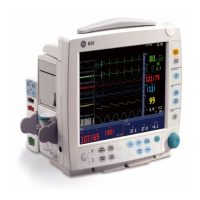Pulse oximetry
12-7
Measurement limitations
• The B30 monitors are designed to minimize the interference of electrosurgery. Under
some circumstances electrosurgery may cause noise on the screen. Therefore, be careful
in interpreting the results, especially the plethysmographic pulse waveform, during
electrosurgery.
• The saturation values may be somewhat higher for smokers. Special care should be
taken with patients who have burns or carbon monoxide (CO) intoxication. When carbon
monoxide intoxication is suspected, always confirm the pulse oximetry reading with a
blood sample measurement.
• Intravascular dyes may cause erroneous readings. For example, methylene blue, indigo
carmine, indocyanine green or any substances that contain dyes, interfere with the SpO
2
measurement.
• Vasoconstrictive drugs, such as phenylephrine hydrochloride and dopamine, may affect
the accuracy of the measurement.
• The pulse oximeter cannot distinguish between oxyhemoglobin and dyshemoglobins, for
example, met- or carboxyhemoglobins.
• Poor perfusion may affect the accuracy of measurement when using the ear probe.
• To avoid erroneous readings, do not use a blood pressure cuff or arterial blood pressure
measurement device, or NMT sensor in the same limb as the SpO
2
sensor.
Checklist
Check that
• Only one module with pulse oximetry measurement is inserted.
• Correct SpO
2
sensor is selected for each patient size.
• The sensor is completely dry after cleaning.
• Sensor or interconnect cable is plugged to the blue connector in the module.
• Sensor is properly connected to the interconnection cable if used.
• Sensor is positioned correctly to the patient.
• SpO
2
is selected for screen through Monitor Setup - Screen Setup.

